#stone age
Text
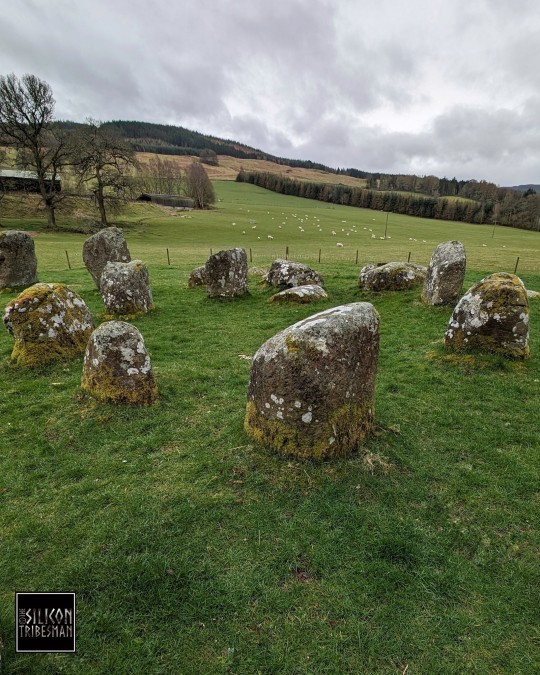
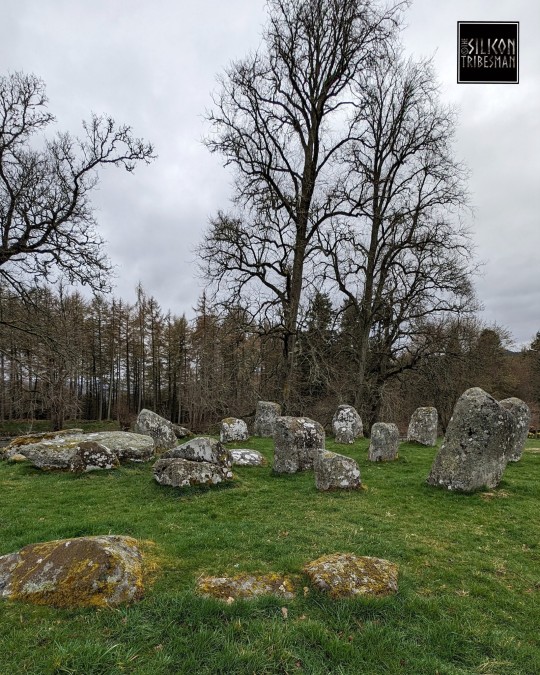
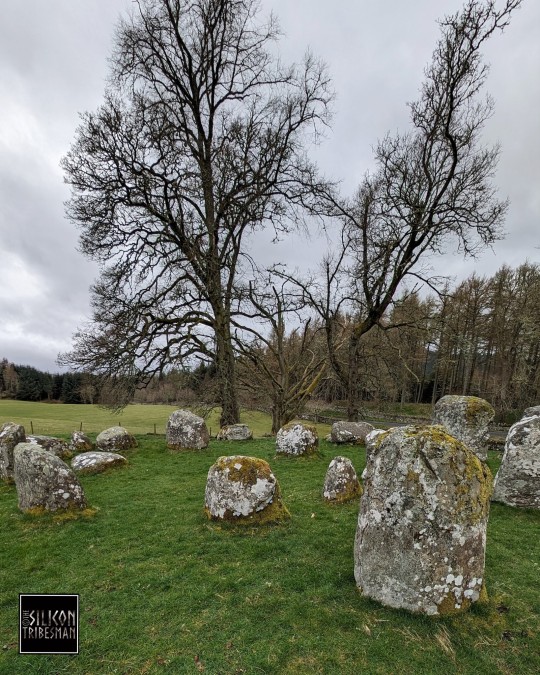
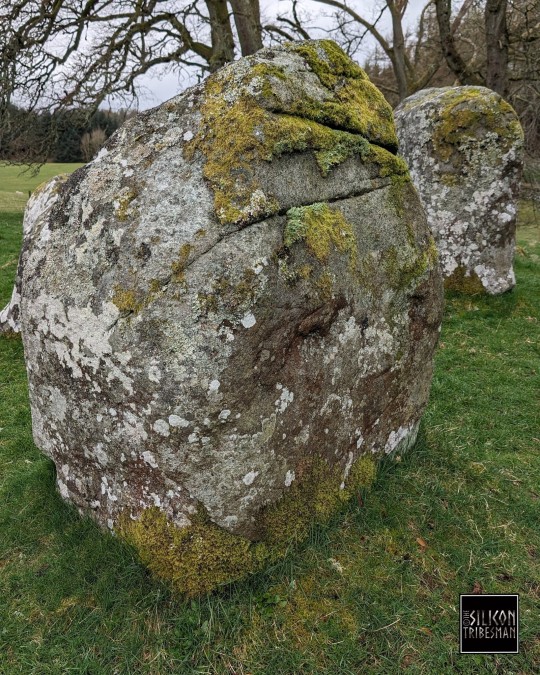

Croft Moraig Prehistoric Stone Circle, Loch Tay, Scotland
#ice age#stone age#bronze age#copper age#iron age#neolithic#mesolithic#chalcolithic#archaeology#prehistoric#paleolithic#prehistory#ancient cultures#stone circle#standing stones#stones#landscape#outdoors#Scotland#ancient sites#Loch Tay
86 notes
·
View notes
Text
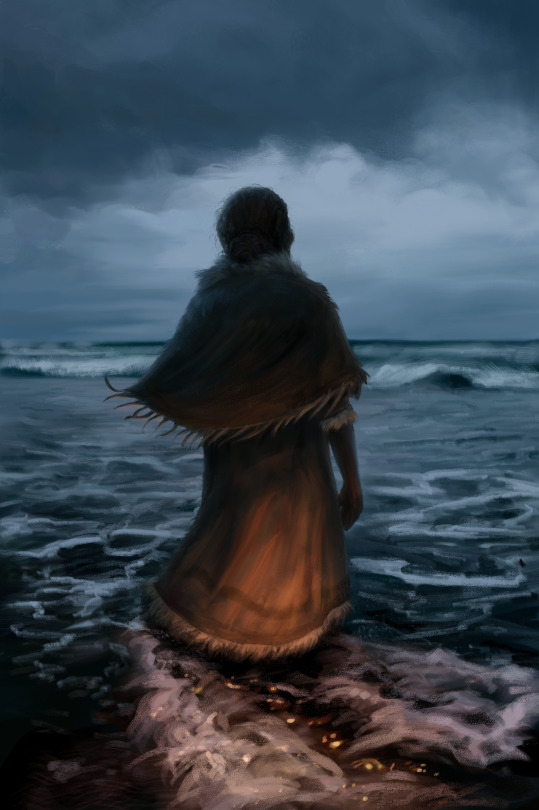
VERGE OF THE WIDER SEA -
My Paleolithic character Nisse at the edge of the western ocean.
[old art]
#paleoblr#paleolithic oc#paleoart#gravettian#aurignaican#My art#stone age#landscape#Prehistoric oc#prehistoric europe#art#artwork#digital art#prehistory#original character art#original character#nisse
3K notes
·
View notes
Text
Oldest medical amputation on record was performed on a Stone Age child in Borneo 31,000 years ago

About 31,000 years ago, a skilled prehistoric surgeon cut off the lower leg of a child hunter-gatherer in Borneo. Now, archaeologists have concluded that this ancient surgery is the earliest medical amputation on record.
The skill of the Stone Age surgeon was admirable; the patient went on to live an additional six to nine years after the surgery, a radiocarbon dating performed by researchers of the individual's tooth enamel revealed, according to a study published online Wednesday (Sept. 7) in the journal Nature.
"It was a huge surprise that this ancient forager survived a very serious and life-threatening childhood operation, that the wound healed to form a stump and that they then lived for years in mountainous terrain with altered mobility," study co-author Melandri Vlok, a bioarchaeologist and postdoctoral research associate at the University of Sydney," said in a statement. "[This suggests] a high degree of community care." Read more.
25K notes
·
View notes
Text
"The Ayla Descent Theory" of Mary Sues
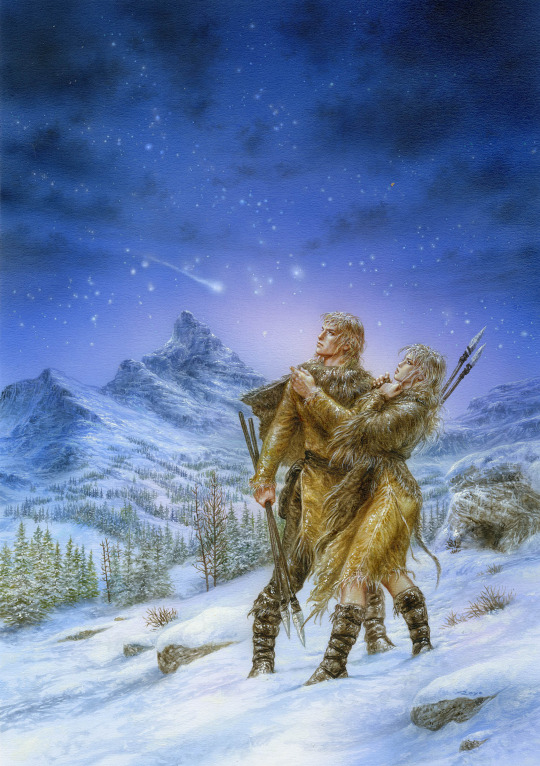
"Children of the Earth," Luis Royo.
After the success of Jean M. Auel's stone age novel Clan of the Cave Bear, there was a very lengthy trend in the publishing world of stone age adventure novels aimed at women that lasted for a decade and only really fizzled out in the early 2000s. After all, "Ayla," the name of the main character of these books, was one of the top baby names of 1987.
The target audience for these books were weird midwestern aunts....you know, the Mists of Avalon and the Mercedes Lackey/Valdemar audience. Therefore, the Clan of the Cave Bear imitators also featured things of interest to the weird aunt audience: Scotland, redhaired women with sharp tongues, commanding wolves, Ireland, Feminism, riding herds of wild horses bareback in scenic locations, Wicca, matriarchial religions, swimming with dolphins....but above all else, American Indians (a culture this audience finds interesting, as anyone who has seen the home decor of a typical weird midwestern aunt can attest), with many novels set in Ice Age America, like Children of the Dawn, Reindeer Moon and the First Americans. Decades later, this audience would form the core fandom for Game of Thrones, and the character of Khaleesi Targaryen in particular.

These books almost assuredly still have a place of honor on the book shelf of the weirdest woman at your job.
Nearly all of these imitators have two of Clan of the Cave Bear's defining traits: 1) a supremely beautiful, usually blonde athletic and statuesque main character over 5'11" who does not realize that she is so beautiful and desirable, who is good at a variety of different skills and is friendly with animals like hawks, dolphins, or horses, and 2) a love triangle between this aforementioned blond but innocent Venus and two bodybuilder muscular he-men cave hunks, one of whom is a blonde guy with long rock star hair (it was the 80s), and the other being a buff black guy with dreadlocks (or otherwise ethnic in some way).
The heroine usually picks the blonde guy in the end, but the audience usually picks the ethnic guy.

In the late 90s and early 2000s, in the broader culture of fandom, it was fashionable to dump on "Mary Sues" (indulgent wish-fulfillment author personas in fanfiction) and the people who wrote them. Accusations of creating a Mary Sue approached a kind of hysteria. Even at the time, when everyone else was getting swept up in this, I thought that getting mad about aunties writing fanfiction showed a loss of perspective, and was a bit silly. Thankfully, we've benefitted from moral evolution: the consensus in fandom now is that writing aspirational characters is a harmless activity that tests a young writer's creative muscles, like the half-Vulcan pretty new ensign on the Enterprise that Kirk and Spock both fall in love with, or a new archer girl who Legolas falls in love with joining the Fellowship. This hate walked hand in hand with insecurities, in the exact same way that people worried about their appearance or concerned with their weight are often cruel to fat people, and there were frequent tests if this or that character in your writing was a Mary Sue.

There was a running joke in this 2000s culture of anti-self insertion called the "Ayla Descent Theory of Mary Sues." The joke was that Mary Sues came into existence because Ayla, the beautiful, athletic heroine of the Clan of the Cave Bear novels, was the ancestor of their entire lineage, as the first known Mary Sue to ever exist in the historical record, described as being a statuesque blonde who did everything right and was always at the center of love triangles, and who changed human history.
According to the running joke, Mary Sues everywhere were descended from Ayla from Clan of the Cave Bear, and she was the first to exist, and Ayla was the explanation of where all the Enterprise's new ensigns main characters fall in love with come from.
404 notes
·
View notes
Text
Led by renowned palaeoanthropologist Lee Berger, researchers said they discovered several specimens of Homo naledi – a tree-climbing, Stone Age hominid – buried about 30 meters (100 feet) underground in a cave system within the Cradle of Humankind, a UNESCO world heritage site near Johannesburg.
"These are the most ancient interments yet recorded in the hominin record, earlier than evidence of Homo sapiens interments by at least 100,000 years," the scientists wrote in a series of yet to be peer-reviewed and preprint papers to be published in eLife.
The findings challenge the current understanding of human evolution, as it is normally held that the development of bigger brains allowed for the performing of complex, "meaning-making" activities such as burying the dead.
The oldest burials previously unearthed, found in the Middle East and Africa, contained the remains of Homo sapiens – and were around 100,000 years old.
Continue Reading
1K notes
·
View notes
Text
The most common mistake people make when thinking about prehistory and how to avoid it.
In "The Dawn of Everything, A New History for Humanity" David Graeber gives what I think might be the best piece of advice I've ever heard for understanding deep human history, and that is to get your mind out of the Garden of Eden.
People speculating about prehistory before modern archeology were quick to frame early humanity as existing in a "state of nature", either with pure innocent tribal communism, or being brutish barbarous cavemen, then something happened to bring us from the state of nature into "society". Did we make a Faustian bargain by domesticating plants and animals? Why is evidence of intergroup violence in prehistory so rare? How did we fall from the innocent state of nature? This, of course, smacks of the biblical creation story, so even if people don't believe it literally, they seem to have a hard time letting go of it spiritually even in a secular context.
This is pretty much nonsense, of course. Humans have existed for over 2 million years. Anatomically modern humans have existed for at least 300 thousand years. Behaviourally modern humans (with symbolism, art, long distance trade, political awareness) have existed for at least 50 thousand years, from our best evidence, but possibly a lot longer. The time between the Sumerians inventing writing and urban living 5,000 years ago and now is only a narrow slice of human history.
If we want to understand human history properly, we shouldn't understand people of the past as fundamentally different from us. They were intelligent, politically aware people doing their best in the world they found themselves in, just like we are today. We didn't fall from innocence with the development of behavioral modernity, religion, farming, war, money, capitalism, computers, or anything else. The world has changed a lot, but people have been experimenting with different ways to live for as long as there have been people, like this example I've posted before about disabled people's role in late pleistocene Eurasian society.
People have been the same as we are now for at least the last 50 thousand years. We have lived in countless different ways and will continue to experiment. There was no fall, and we don't live at the end of history.
330 notes
·
View notes
Photo

Lat 19th Century photo of the entrance of Newgrange, a 5,200 year old passage tomb in Ireland, by R. J. Welch
3K notes
·
View notes
Text

Handaxe discovered at the Olduvai Gorge in Tanzania, 1.2-1.4 million years old
from The British Museum
873 notes
·
View notes
Text

shell necklace made of river mussels
stroked pottery culture, 4800-4400 BC
found in Šárka, Czech Republic
#neolithic#prehistory#stone age#artefact#archaeology#jewellery#stroked pottery culture#czech republic#archeology#my upl#central europe#european prehistory
222 notes
·
View notes
Text
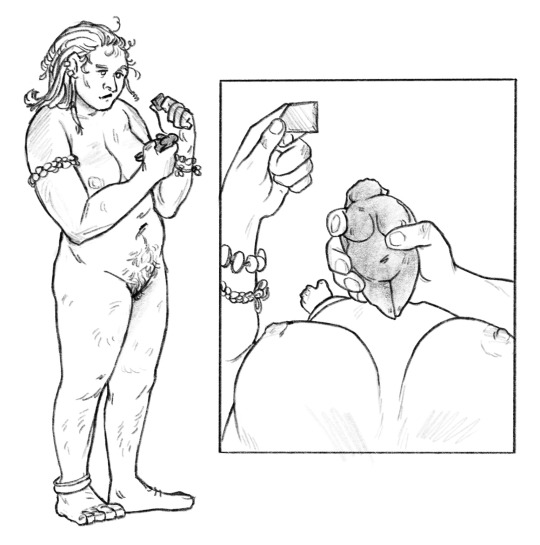
I really love the theory about Venus figurines being self portraits drawn from the sculptor’s point of view; I’m not sure how much credence the theory holds but I enjoy it!! An homage to those inspired artists
#my art#art#illustration#stone age#Venus figurines#venus of willendorf#early humans#artists on tumblr#digital illustration#illustrators on tumblr
387 notes
·
View notes
Text


Two cave art inspired Megaloceros bucks creating their own thunder in the grass. This is a subsection of something bigger I was trying, but this is lovely on its own.
The noise and swirling faint patterns are anti-AI measures and are not present on the actual art print.
#art#palaeo#drawing#palaeosinensis#paleopanthera#illustration#digital art#painting#cave art#pleistocene#stone age#ice age#fossil#fossils#megaloceros#irish elk#megafauna#deer#buck#antlers#rut#fighting#paleo art#reconstruction#paleontology#cave painting
310 notes
·
View notes
Text



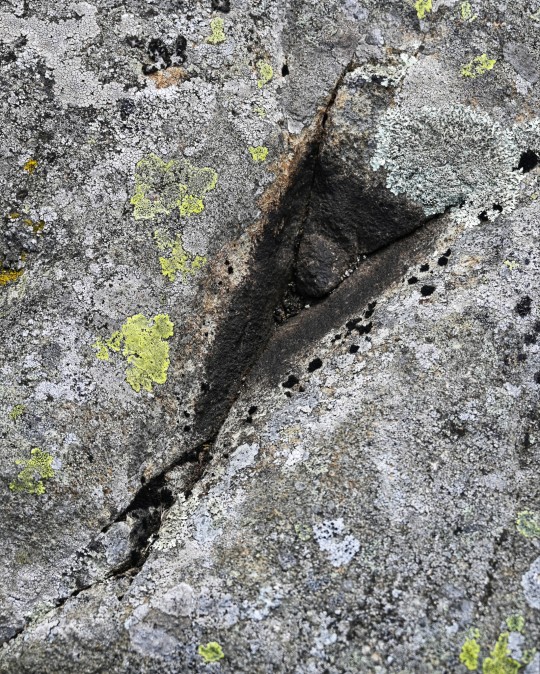
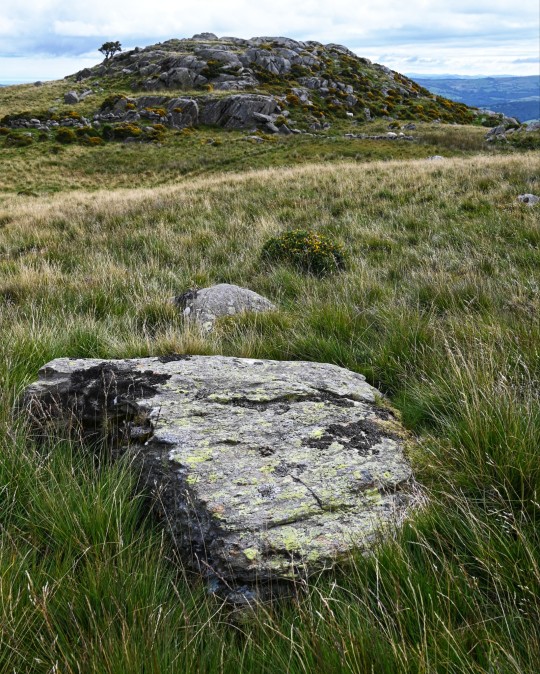
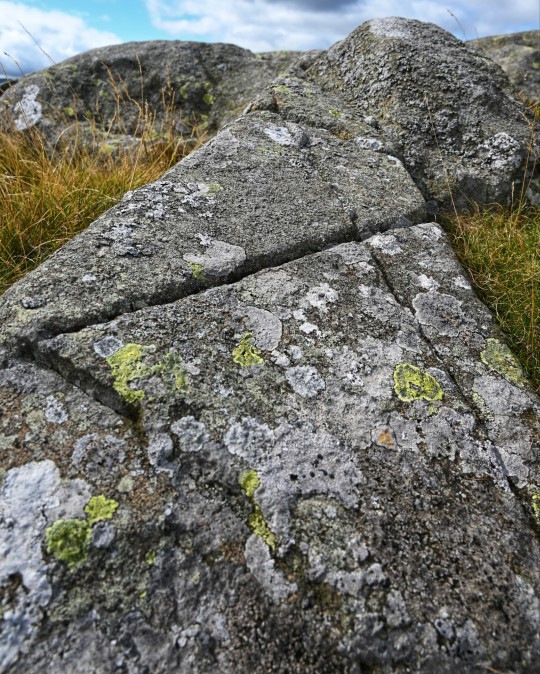

Craig Celynin Ancient Landscape, nr. Rowen, Conwy Valley, Wales
#ice age#stone age#bronze age#copper age#iron age#neolithic#mesolithic#calcholithic#paleolithic#prehistoric#prehistory#landscape#wales#archaeology#geology
4K notes
·
View notes
Text
#i got polls#Stone age#no science just vibes#cave art#paleolithic#Neolithic#neanderthal#archaeology#archeology
1K notes
·
View notes
Text
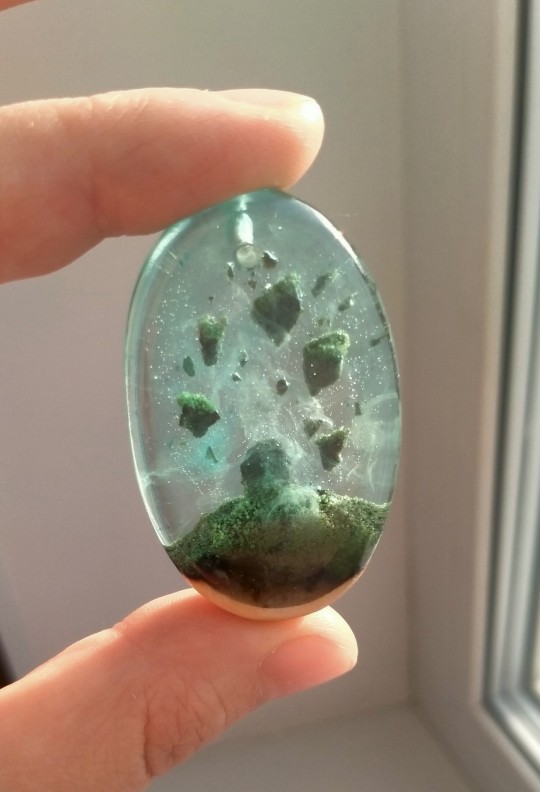


Stone portal around menhir, the fog is luminescent
#resin art#miniature#standing stones#menhir#neolithic#portal#fantasy art#ark#epoxy resin#fog#prehistoric#stone age#my art#craft
294 notes
·
View notes
Text
The Evil Little Hairy Cave People of Europe in Pulp Fiction

From the 1900s to the 1940s, there was a trendy theme in occult and horror stories that the explanation for widespread European legends of fairies, brownies, pixies, leprechauns and other malicious little people, was that they were a hereditary racial memory of the extremely small non-human, hairy stone age original inhabitants of Europe, who still survive well into modern times in caves and barrows below the earth. Envious of being displaced on the surface, these weird creatures, adapted to the darkness of living underground and unable to withstand the sun, still mean mischief and occasionally go out at night to capture someone.... usually an attractive woman....to take to their dark caves for human sacrifice.
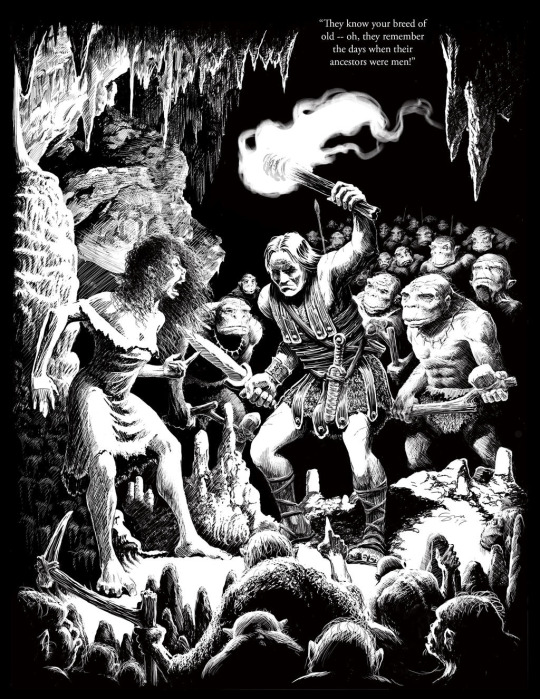
Displaced by the arrival of Indo-European language speakers at the dawn of the Bronze Age, these original, not quite human stone age people of Europe were driven deep underground into caves and barrows below the earth, where they went mad, adapted to the darkness and acquired a fear of daylight, became extremely inbred, in some cases acquired widespread albinism. It is these strange little people who gave the descendants of Europeans a haunting racial dread of places below the earth like mines and caves, and it also is these strange, hairy troglodytes who originally built the uncanny and mysterious menhir, fairy rings, and stone age structures of England, Scotland, and Ireland that predate the coming of the Celts and Romans.
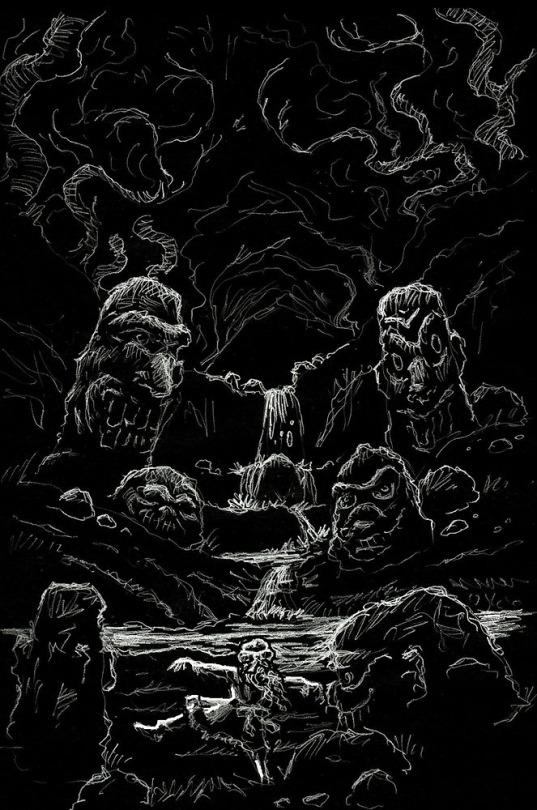
In some cases, these evil troglodytes are usually identified with the mysterious Picts, the pre-Celtic stone age inhabitants of the British Isles. In some cases, they are identified with the Basque people of Spain, best known as the inventors of Jai Alai, and the oldest people in Europe who speak a unique language unrelated to any in the world.
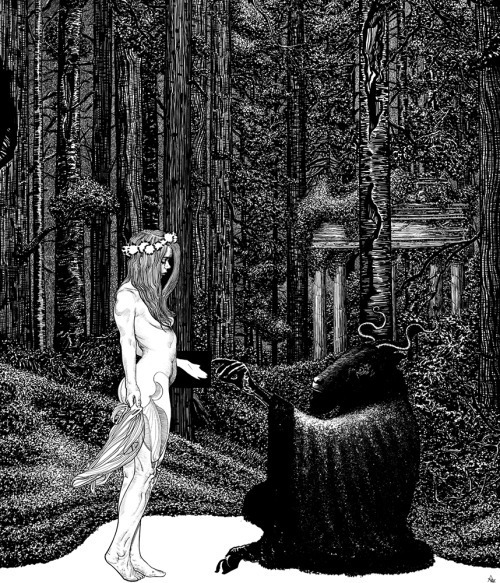
The original codifier of this trend was Arthur Machen, a horror writer who is less remembered than his contemporary, Henry James, but who may be the best horror writer in the generations between Poe on the one end and Lovecraft/CL Moore/Clark Ashton Smith on the other. His story, "the White People" from 1904 (a reference to their strange cave albinism) was a twisted Alice in Wonderland with a girl who is irresistibly attracted to dark pre-Roman stone age ruins and who is eventually pulled underground.
In addition to being a great horror writer, Arthur Machen was a member of the Hermetic Society of the Golden Dawn, an occult organization, and was often seen at the Isis-Urania Temple in London. Many of his works have secretive occult knowledge.
H.P. Lovecraft in particular always pointed out Arthur Machen as his single biggest inspiration, though he combined Machen's dread and occultism with Abraham Merritt's sense of fear of the cosmic unknown, seen in "Dwellers in the Mirage" and "People of the Pit."

Another and scarier example of this trend would be "No Man's Land," a story by John Buchan, a Scotsman fascinated by paganism and horror, who often wrote stories of horrific discoveries and evil rites on the Scottish moors. He is often reduced to being described as a "Scottish Ghost Story" writer, a painfully reductivist description as in his career, Buchan wrote a lot of thrillers, detective, and adventure stories as well. In later life, he was appointed Governor General of Canada, meaning he may be the first head of state to be a horror writer.
It was Buchan who first identified the cave creatures with the Picts, something that another Weird Tales writer decades later, Robert E. Howard, would roll with in the 1920s.

Howard is a very identifiable kind of modern person you often see on the internet: a guy who talks tough, but who was terrified to leave his small town. He created manly man, tough guy heroes like Conan the Barbarian, Kull, and El Borak, but he himself never left his mother's house. It's no wonder he got along well with his fellow Weird Tales writer and weird shut in, HP Lovecraft. With 1920s Weird Tales writers, despite your admiration for their incredible talent, you also can't help but laugh at them a little, a feeling you also apply to a lot of Victorians, who achieved incredible things, but who are often closet cases and cranks who died virgins ("Chinese" Gordon comes to mind, as does Immelmann).
With Howard, his obsession with the Picts and the stone age cave dwelling people of Europe started with an unpublished manuscript where at a dinner party, a man gets knocked out and regresses to his past life in the Bronze Age, where he remembers the earliest contact between modern humans and the original inhabitants of the British Isles, the evil darkskinned Picts. This is a mix of both the "little cave people" story and another cliche at the time, "the stone age past life regression novel," another turn of the century cliche.
Still with the Picts on his mind, Howard would later create Bran Mak Morn, a Pict chieftain, who predated Kull and Conan as his Celtic caveman muscle hero. Howard was of Irish descent and proudly anti-Colonial and anti-British, with his Roman Empire and Civilized Kingdoms as a stand in for the British and other Empires, which he viewed as rapacious and humbug, a view shared by his greatest inspiration, Talbot Mundy. His "Worms of the Earth" gets to the heart of why these little cave people scare us so much: they remind us that we live on land that is impossibly ancient and we don't fully understand at all.

It was another Weird Tales Writer a decade later who wrote one of the last stories about the little hairy cave people of Europe, though, Manly Wade Wellman in 1942. Wellman was mainly known for creating the blond beefcake caveman hero Hok the Mighty set in stone age times, and for his supernatural ghost stories of Silver John the Balladeer set in modern, ghostly Appalachia (like many ex-Weird Tales writers, he made a turn to being a regional author in his later career, in the same way Hugh B. Cave became a Caribbean writer), but Wellman also had a regular character known as John Thunstone, a muscular and wealthy playboy known for his moustache who used his great wealth to investigate the supernatural and the occult. Thunstone had a silver sword made by St. Dunstan, patron of Silversmiths, well known for his confrontations with the Devil.
Most John Thunstone stories featured familiar stories, like a demon possessed seance and so on, but one in particular featured a unique enemy, the Shonokins.
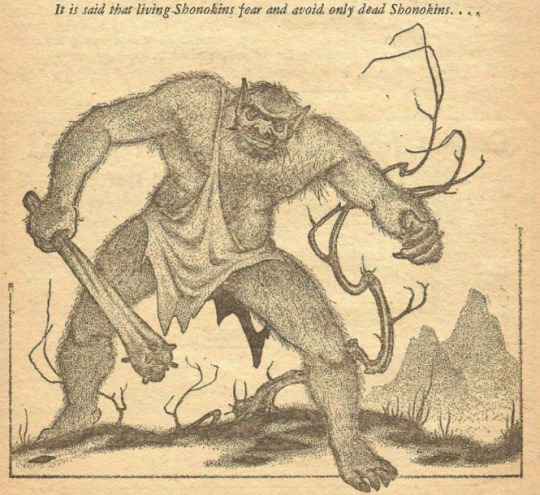
The Shonokins were the original rulers of North America, descendants of Neanderthal man displaced by American Indians. This fear that the land we live is ancient and unknowable and we just arrived on it and don't know any of its secrets is common to settler societies, who often hold the landscape with dread, as in Patricia Wrightson's fantasies of the Australian Outback. It was easy enough to transport the hairy cave people from the Scottish Moors to North America. I suspect that's what they are, a personification of a fear shared in the middle class, that in the back of their minds, that everything they have supposedly earned is merely an accident of history, built by rapacity and the crimes of history, and that someday a bill will come due.
A text page in the May 1942 issue of Weird Tales gives strange additional information on the Shonokins not found elsewhere:
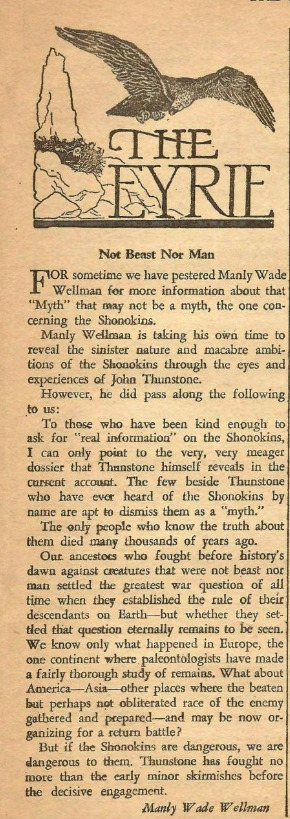
Since then, there have been too many examples of evil cave people who predate Europeans. Philip Jose Farmer's "The All White Elf" features the last survivor of a pre-European people who live in caves. A lot of other fiction of course has featured the Picts, but according to our modern scientific understanding, which describes them as much, much less exotically, as a blue tattooed people not too different and practically indistinguishable from the Celtic tribes that surrounded them, and which they eventually blended into.
411 notes
·
View notes
Text
Ancient humans were building large wooden structures – possibly houses – almost half a million years ago. The discovery, the earliest evidence of wooden construction, suggests that some ancient communities were far less nomadic than we have assumed.
“These people were behaving in ways I hadn’t expected,” says Larry Barham at the University of Liverpool, UK. “It’s a disruptive discovery.”
Barham and his colleagues uncovered the evidence at Kalambo Falls, an archaeological site in Zambia. In 2019, they spent a month excavating a sandbar some 300 metres upstream of the falls.
One of the first artefacts they found was a wooden tool, probably a digging stick. “The number of sites where wood is preserved is small,” says researcher Geoff Duller at Aberystwyth University, UK.
As they continued to dig, they made another discovery: a 1.4-metre-long log overlying an even larger log that was too big to fully excavate during their month-long project. They saw that the overlying log had been worked with tools to fashion a deep notch midway along its length. This allowed it to interlock with the underlying log at a 75-degree angle, creating a relatively sturdy joint. The researchers speculate that the two interlocking logs were once part of a larger wooden structure.
Duller then dated the artefacts using a technique called post-infrared infrared stimulated luminescence. This involves measuring the time since the mineral grains in the sand that surrounded the wood were last exposed to light prior to their burial. The mineral grains – and the artefacts they surround – were buried about 476,000 years ago, which implies that the wooden structure was built before our species evolved. The engineers therefore belonged to an earlier human species, possibly Homo heidelbergensis.
320 notes
·
View notes